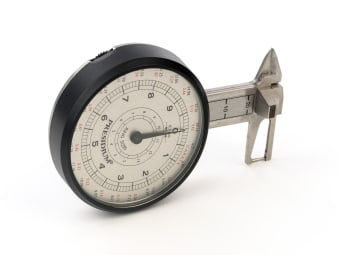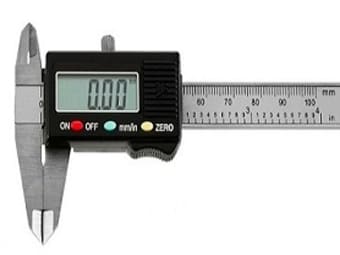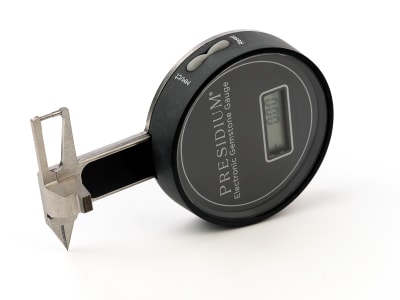Introduction:
A practicing gemologist or jeweler will always have a digital
measuring gauge within easy reach. This will provide accurate
measurements required for many tasks during a working day. What are
the dimensions of that loose stone? Covered.
What is the inside diameter of this ring? Got it. Using a
digital gauge for measuring gemstones will yield better precision and
accuracy than an analog gem gauge or ruler. It is also a lot easier to
see the result when it is presented in a display, rather than trying
to figure out where the needle points to on analog gauge.
What is a digital measuring gauge?
The digital measuring gauge appears in two fundamentally different
form factors. One is like a ruler and the other is generally round and
has spring-loaded calipers that will shut around anything being
measured. Most gemologists and jewelers will own both, with each being
better for certain tasks. The ruler style will be easier to read and
handle for most tasks and the ability to hold the calipers open makes
it easier to measure and compare when looking at a parcel of stones or
comparing ring bezels, for example.
The round format with the spring-loaded calipers work well for
smaller goods, and they are uniquely able to help measure the depth of
a mounted gemstone if there is access to the gallery. The gallery is
the 'basket' that holds the gemstone, which will often be open below.
This allows the pincer-style of spring-loaded calipers to access the
base or culet of the gemstone. In this way, a gemologist can measure
how deep a stone is.
In short, a Digital Measuring Gauge can be used to take four kinds of readings:
- Outside Measurements. Like length, breadth and circumference.
- Inside Measurements. Like the inner diameter of a ring to establish the ring size.
- Depth Measurement. Typically from the table of a gemstone to the culet.

What should I look for in a digital pocket gauge?
When looking for a digital measuring gauge, avoid the cheapest
options, as they will not be as accurate. With jewelry and gemstones
we will not be measuring large items, so do not get drawn to something
simply because it will measure up to 4 inches/10cm. However, given the
tiny size of the items we do measure, we need to be accurate down to
one-hundredth of a millimeter. Below are some of the specifications
that you should be looking for:
- Measuring Range: Zero to not more than 100mm/10cm/4 inches.
- Resolution: 0.01mm or .0001 inches.
- Power Source: battery or rechargeable via USB.
There may be a locking screw to secure the gauge open to a certain point.
There should be buttons to "Zero out" or "Tare"
the caliper in any position and also to convert between millimeter and
inch measurements easily.
You might find a backlighting function and a battery status indicator useful too. Most use the same small batteries that one would use in a car remote.
While this article focuses on a digital measuring gauge, the analog type will still get the job done, albeit needing a little more practice and steadier hands to read the marks.
Before Using the Digital Measuring Gauge.
1. Wipe the surface of the slider and all measuring faces with a clean, dry cloth. When we have to ensure accuracy to 1/100th of a mm, any surface grit or fluff will have a significant effect.
- If there is one, loosen the locking screw.
- Switch the unit on.
- Ensure the battery has charge, generally indicated by a small battery logo like we see on a cell phone.
- Move the display and slider assembly to ensure it is working.
- Move the slider until the two external measuring faces touch gently.
- Press the ZERO button to set the caliper to zero.

How to Measure with a Digital Measuring Gauge.
- The above steps have got us ready to work with our instrument.
- Place your gemstone on a flat surface. A paper desk pad is better than a cloth, which you may pinch.
- Close the external measuring faces to fit snugly against the gemstone.
- Read the measurement on the LCD display.
How to Estimate the Carat Weight of a Gemstone
For many in the appraisal industry, the measurements provided by a digital measuring gauge allow the calculation of some important additional information with every mounted gemstone appraisal. What do we mean by this? If an appraiser is looking at a piece of jewelry with a mounted gemstone, and they have been tasked with valuing it so its owner can ensure it is appropriately insured for example, they need to make an accurate estimation of the gemstone’s weight. However, with the gem being held in place with claws or by a bezel, it is not possible to remove it and reset it in the course of a normal appraisal. A different approach needs to be taken.
If you can get accurate dimensions on your gemstone, it is possible
that these measurements can be used to calculate the approximate
weight of the gemstone with a remarkable degree of accuracy. The
degree of accuracy relies on you accounting for a few factors.
-Firstly, the correct identification of the stone, because differences in specific gravity will mean stones with identical dimensions can have a significant weight difference.
-The cut of a stone is important. A mixed cut will often have a 'fat belly' relative to the appropriate proportions for the table view of the stone.
-A thick girdle will make a stone significantly heavier than a thin girdle since that extra is all sitting at the stone's largest outside dimensions.
-Antique cuts may have a culet too and not taking this into account will result in an underestimation of the weight.
-There are online calculators to assist with this. Look for one that allows you to input the gem species, which means the relative density for a given size is taken into account. It must also allow you to select the cut and preferably also enter a girdle size and allow for a culet in the depth measurement.

